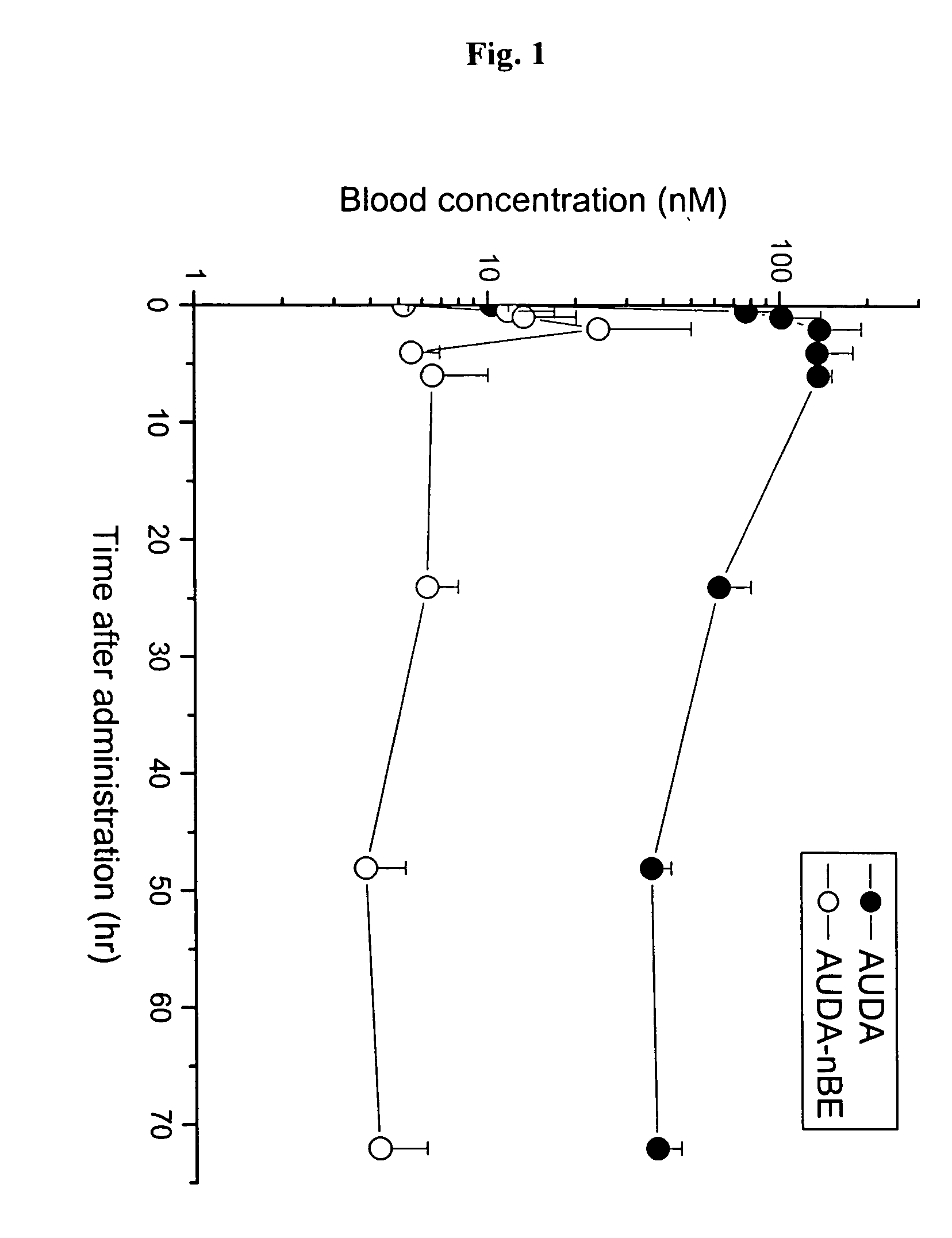Use of cis-Epoxyeicosantrienoic acids and inhibitors of soluble epoxide hydrolase to reduce pulmonary infiltration by neutrophils
a technology of soluble epoxide hydrolase and cis-eicosantrienoic acid, which is applied in the direction of biocide, drug composition, and elcosanoid active ingredients, can solve the problems of smoking cessation and many features of copd that do not appear to resolv
- Summary
- Abstract
- Description
- Claims
- Application Information
AI Technical Summary
Benefits of technology
Problems solved by technology
Method used
Image
Examples
example 1
Materials and Methods
[0103] Reagents and Chemicals.
[0104] 12-(3-adamantane-1-yl-ureido)-dodecanoic acid butyl ester (AUDA-nBE) and 1-cyclohexyl-3-tetradecyl urea (CTU, Internal standard) were synthesized in our laboratory. These products were purified by recrystallization and characterized structurally by 1H- and / or 13C-NMR, infrared, and mass spectroscopy. HPLC-grade methanol, acetonitrile and ethyl acetate were purchased from EMD Chemicals Inc. (Gibbstown, N.J.). Formic acid was obtained from Sigma-Aldrich (St. Louis, Mo.). Water (>18.0 MΩ) used was purified by NANO pure II system (Barnstead, Newton, Mass.).
[0105] Equipment.
[0106] LC-MS-MS analysis was performed using a Micromass Quattro Ultima triple quadrupole tandem mass spectrometer (Micromass, Manchester, UK) equipped with atomospheric pressure ionization source [atomospheric z-spray pressure chemical ionization (APcl) or electrospray ionization (ESI) interface]. The HPLC system consisted of a Waters model 2790 separatio...
example 2
[0137] Tobacco smoke Exposure Characteristics.
[0138] TSP, nicotine, and carbon monoxide levels in the tobacco smoke during the 3 day study are shown in Table 1.
[0139] Pharmacokinetics.
[0140] To estimate blood concentration of AUDA-NBE and AUDA in SH rats, pharmacokinetic study was performed with single dose. FIG. 1 shows blood concentration-time profiles of AUDA-NBE and AUDA in SH rats following subcutaneous administration. AUDA-nBE was metabolized to AUDA, which was a potent inhibitor of sEH. Thus, AUDA-NBE was administered as a prodrug for AUDA to improve bioavailability. The half-life of AUDA was 22 hr.
[0141] BAL.
[0142] Total number of cells in the BALF was increased significantly after 3 days of tobacco smoke exposure. Subcutaneous injection of AUDA-nBE before exposure significantly decreased the number of BALF cells (FIG. 2). Treatment of animals with both AUDA-NBE and EETs before exposure to tobacco smoke for 3 days resulted in further decrease in total BALF cells compare...
example 3
[0143] Pulmonary inflammation was induced and persisted in rats exposed to tobacco smoke at an average concentration (mean±S.D.) of 76.4±16.0 mg TSP / m3 for 3 days. Subcutaneous injection of AUDA-nBE prior to exposure to tobacco smoke significantly decreased the number of cells in BALF recovered from tobacco smoke-treated rats associated with significant reductions in macrophages, neutrophils, and lymphocytes. The combination of sEH inhibitor and EETs further reduced TS-induced inflammation compared with sEH inhibitor alone.
[0144] There is a considerable amount of research to support a key role for inflammation as a driving force to cause the airway epithelium to undergo changes leading to the loss of ciliated cells, hypersecretion of mucin, bronchitis, emphysema, and lung cancer. Smoking causes a local cytokine secretion in the lung, which leads to an infiltration of leukocytes into the airways and alveolar destruction. Reactive oxygen species (ROS) have been shown to play an impor...
PUM
| Property | Measurement | Unit |
|---|---|---|
| Dimensionless property | aaaaa | aaaaa |
| Dimensionless property | aaaaa | aaaaa |
| Body weight | aaaaa | aaaaa |
Abstract
Description
Claims
Application Information
 Login to View More
Login to View More - R&D
- Intellectual Property
- Life Sciences
- Materials
- Tech Scout
- Unparalleled Data Quality
- Higher Quality Content
- 60% Fewer Hallucinations
Browse by: Latest US Patents, China's latest patents, Technical Efficacy Thesaurus, Application Domain, Technology Topic, Popular Technical Reports.
© 2025 PatSnap. All rights reserved.Legal|Privacy policy|Modern Slavery Act Transparency Statement|Sitemap|About US| Contact US: help@patsnap.com



